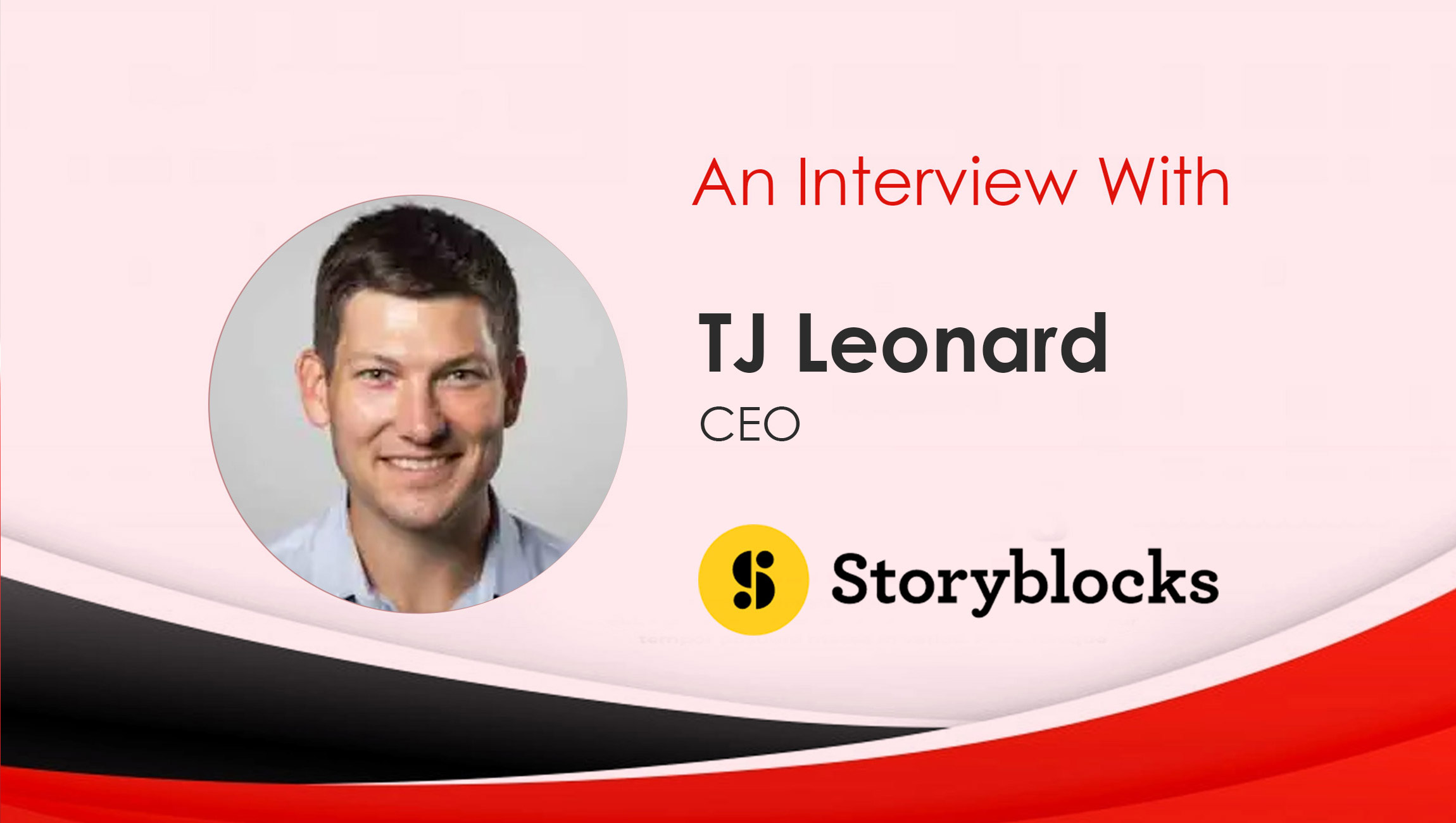One of the basics in any online marketing process involves stronger attention to visual elements and stock media, TJ Leonard, CEO at Storyblocks shares a few tips to help enrich the strength of your marketing visuals:
________
Can you tell us about Storyblocks and some key highlights from your marketing journey thus far?
Storyblocks makes it possible for creators and businesses to keep up with the growing demands for modern video content. Our platform enables storytellers to effectively and effortlessly bring their stories to life. Storyblocks offers flexible subscriptions, unlimited downloads, a royalty-free demand-driven library and enterprise licensing with comprehensive coverage. It is our role in the marketplace to help people pursue their creative vision without wasting time or money.
A key highlight from our marketing journey over the past year includes our Re: Stock initiative, which embodies our business’ commitment to increasing representation in stock media. We’ve approached this journey by hiring creators from marginalized communities to create content that is more reflective of the diverse world we live in. We believe that every story needs to be told, and we have the ability to empower our customers to do so by providing more diverse and inclusive stock content in our library.
Marketing Technology News: MarTech Interview with Laura Taylor, CMO at Crayon
In today’s online marketing space, it is crucial for marketers to know how to adapt to changing visual trends and identify the right visual sources to meet their campaign requirements…How have you seen trends change in the marketplace over the years when it comes to the use of stock images and stock media to influence visuals in marketing?
In today’s online world, it is crucial for marketers to know how to adapt to the changing trends in order to meet specific campaign requirements. In terms of marketplace trends, stock media is an essential part of scaling production outputs as production timelines shrink, along with the size of budgets. The stock media model allows creators and business owners to confidently increase the output of their video creative.
In addition to this, the stock media model also allows creators to visualize their creative deliverables in ways that enable personalization, elevate levels of inspiration and output creative work that helps them achieve their business goals effectively.
Can you talk about the global stock media / stock platforms and how they have evolved over the years?
Over the years, creators and businesses have been tasked with the challenge of keeping up with the market demand by being asked to create more, with less resources. Stock media platforms have evolved by playing an integral role in rewriting the rules for how to scale your production output. As software has evolved, and the process for media creation has evolved, so have stock media platforms. The barrier to entry for media creation is a lot lower, and we’re seeing platforms that are optimized to serve creators and businesses at varying levels of expertise and size.
With the emergence of online video editors, preset templates, and digital asset managers, the ability to create and collaborate effortlessly is more tangible for teams of all sizes. In addition, there is more of a push to meet the needs of visual artists and animators that desire to enhance their creative projects through graphic assets that greater evidence a new direction for the future of media.
What should marketers be doing to differentiate their visuals across their blogs, podcasts, videos and other marketing assets today to help their brand stand out in the crowd?
Marketers should develop a distinctive voice, along with a relatable look and feel that resonates with their target audience to differentiate themselves in the current market. Foundationally, that voice can be grounded in the actions of an organization. Setting up processes at the core of your brand that build trust in the eyes of your audience are paramount.
From a visual perspective, it’s important to audit your brand and ensure that your assets are optimized appropriately across channels. What works on Instagram won’t work on YouTube. Keep abreast of current trends and don’t be scared to experiment with new features, platforms or asset types.
Marketing Technology News: MarTech Interview with Shoel Perelman, VP Product Management at Pegasystems
For marketers who need a high volume of visual media to meet marketing requirements, what barriers should they be looking at overcoming to ensure a steady flow of footage/media that is properly licensed for use?
For marketers who need a high volume of visual media to meet marketing requirements, it’s imperative to keep an eye on whether the assets being utilized are royalty-free. When you see this designation, it means that anything you download is yours to keep forever. With royalty-free assets, you won’t need to track licenses on a per project basis.
With high volume can often come high costs which is why it’s important to work with unlimited models (such as Storyblocks!) that allow you to avoid paying for individual assets. This model allows you to try out multiple options quickly and find the perfect fit, so you can create more and spend less, without sacrificing quality.
Distribution rights are also important to consider. Make sure that you can distribute your finished projects anywhere, at any time. Avoid licenses that have expiration dates and have location restrictions.
How do you feel the future of stock visual / stock images will evolve?
Stock media will evolve by acclimating to the remote world that we are moving towards. It will allow for greater opportunities for folks to use platforms to empower businesses to create more, test into more audience segments, and experiment with emerging technologies and asset types. 3D models will continue to grow in the future, as questions and ethical constraints will be raised in the age of deep fakes. The metaverse will also have a vast impact on these conversations.
Overall, consumers will have a desire to break past the confines of homogeneity, as the media landscape will be challenged to create and distribute more stories that are authentic and representative of the world that we live in.
Do you have any last thoughts, takeaways, digital marketing or martech tips/best practices to share?
Going into 2022, digital marketers should be on the lookout for more opportunities to streamline organization’s creative workflows. With a remote-first world, it will be essential to ensure that we are creating a work environment that supports asynchronous communication, scalable creation and evolved production practices.
Marketing Technology News: MarTech Interview with Andy Stevens, Chief Data Officer at Clear Channel International

Storyblocks is a different kind of content company delivering a fresh approach to meet the creative needs of a new generation of storytellers. Built on the belief that all stories deserve a chance to be told, Storyblocks provides video, audio and images through its unique subscription model. By offering unlimited downloads and continually adding fresh content, Storyblocks challenges the paradigm that your ambitious creative vision requires deep pockets. Headquartered in Arlington, Virginia, Storyblocks has been recognized by the Inc 5000 list seven consecutive years and was recently named as one of Washington D.C.’s Top Workplaces by The Washington Post, and among the Best Places to Work by the Washington Business Journal.
TJ Leonard is the CEO of Storyblocks, a different kind of content company delivering a fresh approach to meet the creative needs of a new generation of storytellers. Built on the belief that all stories deserve a chance to be told, Storyblocks provides video, audio and images through its unique subscription model. TJ is a New Hampshire native, who graduated from the University of Virginia and MIT’s Sloan School of Management, and lives in Washington DC with his wife and two kids.
Missed The Latest Episode of The SalesStar Podcast? Have a quick listen here!
Episode 111: Driving Better Productivity within your Product Team: with Kristina Simkins, VP of Product at Lessonly by Seismic
Episode 110: Driving Sales-Marketing Unity with Chetan Chaudhary, Chief Revenue Officer at Scale AI
Episode 109: B2B Revenue Generation Tactics with Michelle Pietsch, VP of Revenue at Dooly.ai











